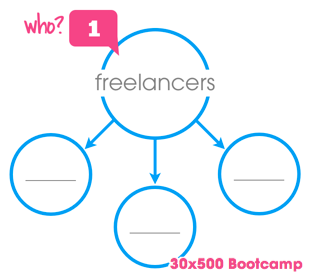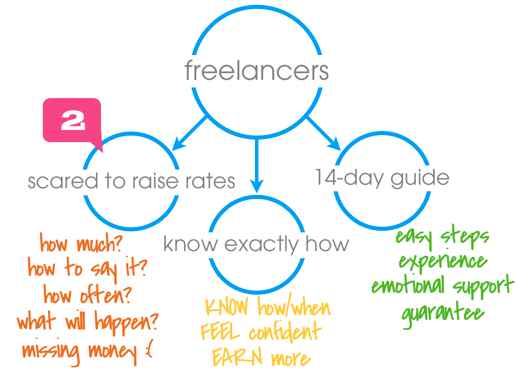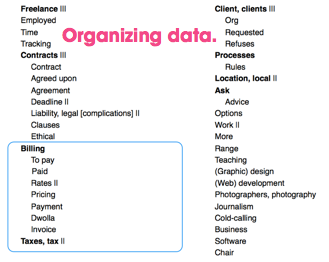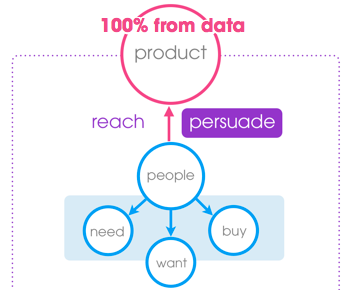Stop me if you’ve heard this one. Have you ever found yourself mired in this process?
- Come up with idea!
- Build idea!
- Put idea online…
- Wait for sales…
- …wait for sales…
- Double down and try to figure out “product-market fit”, in other words: Who wants to buy this?
Over the years, I’ve watched countless friends & acquaintances get stuck in this process. If you make it to Step 6, you’re an outlier. Most folks get stuck between Steps 1 and 3. That’s where the worst doubt & procrastination (a result of fear) set in. Some folks have been re-running Steps 1 - 3 over & over for years.
If you do make it to Step 6, though, you come face to face with the high probability of Hidden Step 7: Give Up, wherein you struggle to find a repeatable source of sales… and can’t.
Lots of strategies have come out to “fix” this process. These strategies fall into two camps:
- Get you past Step 3: Ship The Damn Thing more often, faster (“Lean”)
- Hopefully carry you from Step 6: Flail to actual sales, instead of the nearly inevitable Step 7: Give Up (“Customer Development”)
Oofta. These approaches are both flawed – they start off by accepting the validity of the original process, and trying to modify it.
The real trick is to bypass this process entirely
Because the original “process” (such as it is, formed of unconscious wishes and unicorn spit) is not valid. Not in the slightest. It has no redeeming qualities whatsoever. Let’s not waste time polishing a turd.
In 30x500, Alex and I teach our students a better way. And today I’m going to teach it to you. I used to think of this as a process…but it’s nothing so linear or fancy. It’s really a set of questions, and techniques and tools for answering them.
You need to answer just 3 simple questions
And these will form the backbone of your success. Yes, really. You just need to know…
- Who am I serving?
- What do they need/want, and are they ready to buy?
- How can I reach them and persuade them?
These are big questions, true. But they are simple. And every time you answer one of them, your path will become clearer & clearer.
The secret sauce is that, if you work on them diligently, each answer leads to the next. This approach builds momentum.

And you start it before you ever even think of building a product. You don’t ask, “Who would buy this?” you ask, “Who wants to buy something, and what is it?” You start with the customer first.
1. Who are you serving?
You can’t ask “What do they want?” without having a “they” in mind. But, while there’s all kinds of startup chatter about “niche selection” and how critical it is, this step is not a big deal. Repeat: NOT a big deal.
In previous editions of 30x500, Alex and I made a big mistake. We allowed our students, in this stage of class, to spin out of control. Faced with such a momentous choice, they came down with existential angst and refused to make a decision. In short, they ground to a halt at Step 1.

Now I shake people and cry, “Don’t get fancy! Fancy equals death!”
I tell them: Are you a Ruby developer? Then serve Ruby developers. Are you a UX designer? Serve UX designers.
This isn’t a choice you have to live with forever. But you have to choose now and move forward now. And you can’t afford to pick far afield — or even near-afield.
You can’t afford to get creative
When you start a new business, you start a vicious battle with entropy. Inertia, habit, circumstance – they’re all conspiring to end your product ambitions before you make a single dollar. You can’t afford to throw away even a single advantage, and that’s exactly what you do if you choose an audience you don’t belong to, with all the connections & rapport that means.
In other words: You’re being chased by a hungry bear. Drop your fancy camping gear, or the bear will eat you.
2. What do they need/want, and are ready to buy?
And here is where the real value starts to happen. Let’s say you’re a Ruby developer so (*shakes finger*) you’re going to serve Ruby developers. Now you need to research them, to find out what Ruby developers need, want, and are ready to buy.

This example comes from the 30x500 Bootcamp where we dissect the freelancer audience as an exercise!
Yes, research. No, you cannot rely on what your gut tells you. Cuz your gut is an uneducated fool who only just woke up… your gut has only been in the community, not studying the community.
You do research like this:
- Find out where Ruby developers hang out online.
- Lurk with a purpose.
- Write down pain points, beliefs, worldviews, complaints, questions, struggles, products, desires.
- Do this a lot…10, 20, 30 hours, before you set out to try to create a product.
And once you’ve gathered a good base set of data, you:
- Organize it, distill it, label the patterns.
- Use these to brainstorm nearly infinite product concepts.
Hmmm…”organizing data.” Does that sound like the wild thrill of the idea hunt? No. Are you writing code or slinging pixels? No. But where have those got you before?

These boring steps can solve all your problems
As Edison once remarked, “Opportunity is missed by most people because it is dressed in overalls and looks like work.” The 30x500 approach has a distinct whiff of overalls and manure-shoveling about it. (Although, frankly, if you love making money, you’ll find it enjoyable. I love it.)
What’s amazing about these particular overalls is this:
Take a look at the following issues. You’ve probably experienced them before. Most folks would tell you, “Oh, that’s just what it’s like when you ‘do a startup.’” But, like the bone-headed default process I talked about earlier, there’s nothing normal or natural about them:
Will anyone want this? Use the 30x500 approach, and you can say: Yes! And feel secure in saying so — because you didn’t start with an idea, and then hope people want it, you started with what people wanted and then made it.
They need it, but do they want it? Start with data and you can know, by observing their buying behavior. Do they just bitch and never buy? You can tell, by studying them.
I dunno…I’m afraid… While research can’t solve fear, you can learn to stop fear in its tracks by asking yourself, “Where’s the evidence?” And because you will have based your decisions on research, you can revisit it and prove to yourself that your decisions were sound, just like a warm cuddly blanket and flashlight in the dark.
How can I sell it to people? Do things the “boring” way and you’ll have the data you need to speak your customers’ language, talk about their pains the way they do, and what they want to achieve, too.
How do I get all this in front of potential customers? Again, do your research first, and you’ll be prepared. You’ll already know the places where your target audience hangs out. You can reach them there. And you know what they’re interested in, what they struggle with, and that gives you a springboard for making content that will attract them.
Which brings us to the next and final question…
3. How can I reach my potential customers and persuade them to buy?
Fact: If you can market effectively, you can make sales before you build the product (pre-sales). But if you ship a product and have no way to market it, you can’t make any sales at all.
And that’s why, in the 30×500 approach, you figure out your marketing before you ever set pen to paper, code to Textmate, or pixels to Photoshop. The opposite, in fact, of the way most people do it.

It’s not much extra work, either, because every step of the approach so far has been channeling you towards a successful marketing strategy:
- You’ll already know where to find your potential customers (because you’ve already been studying them for ages)
- You’ll already know what they want, need, read, and share (because you’ve already been studying them for ages)
Isn’t that amazing? The 30×500 questions tie it all up with a shiny ribbon.
So, ask yourself the 3 questions…
Because if you can answer them — if you do the work to truly answer them, from data — the answers will lead you to…
- build a product paying customers already want…
- gather the ingredients needed to persuade them to buy, and…
- learn how to get their eyeballs on your marketing in the first place.
Voila. All you’ve got to do is tug on that ribbon (hard!), and it’ll unfold into a beautiful, profitable product.
Skip any of the steps, fail to answer any of the questions, though, and what you’ll have is a tangled mess. A mess you can’t escape by “pivoting” or “getting out of the building”.
Is it really that simple?
Yes, that really is the heart of it. That’s how I’ve made all the money I’ve made so far in the product business (which, frankly, is a lot).
But, like chess, the rules are simple…but it can take a lifetime to master the game. I should know — this is the approach we teach in 30×500, and we’re currently on the 4th or 5th iteration of how we teach it. We’ve gone from telling students to “Go out there and look for this stuff in forums” to giving step-by-step, systematic instructions on how to skim and mine a forum, how to organize your findings, how to turn that into product concepts and how to turn all of that into marketing material, with rubrics and instructions.
Yep, it’s a challenge, but if you’re game, the rewards are intense. Intensely profitable.

